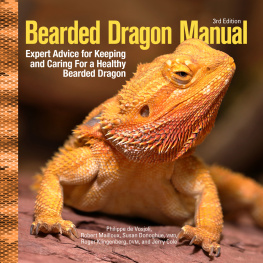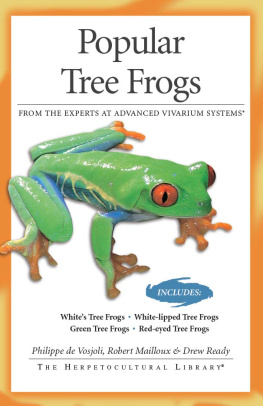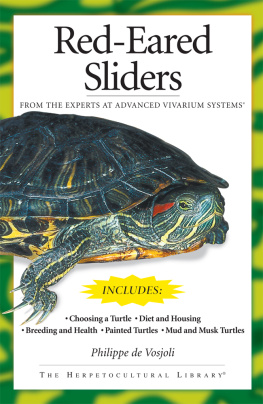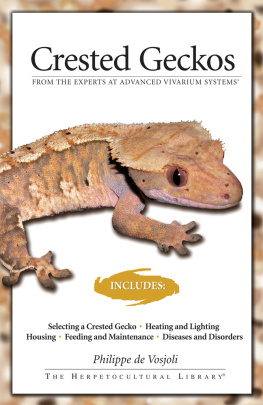June Kikuchi, Editorial Director
Jarelle S. Stein, Editor
Karen Julian, Publishing Coordinator
Tracy Burns, Jessica Jaensch, Production Coordinators
Indexed by Melody Englund
Front cover photo by David Northcott; back cover photo courtesy of www.grazianireptiles.com.
The additional photographs in this book are by David Barker, pp. 4, 68, 1012, 22, 24 (bottom), 34, 35, 36 (bottom), 50, 59, 63, 65, 67, 69, 70, 79 (bottom); Bill Love, pp. 9, 25, 64; John Patton, p. 14; Philippe de Vosjoli, pp. 16, 20, 21, 24 (top), 66; Sandmar Enterprises, p. 17; Neodesha Plastics, p. 18; David Northcott, p. 32; www.grazianireptiles.com, 4043, 459, 5154, 56, 57; www.alanboschreptiles.com, p. 36 (top); Isabelle Francais, p. 60; Chris Wood, p. 61; Roger Klingenberg, pp. 7275,79 (top).
Copyright 1992,1998,2003 by Advanced Vivarium Systems
All rights reserved. No part of this book may be reproduced, stored in a retrieval system, or transmitted in any form or by any means, electronic, mechanical, photocopying, recording, or otherwise, without the prior written permission of Advanced Vivarium Systems, except for the inclusion of brief quotations in an acknowledged review.
LCCN: 96-183295
ISBN-10:1-882770-72-2
ISBN-13: 978-1-882770-72-4
eISBN-13: 978-1-937049-69-0

An Imprint of I-5 Press
A Division of I-5 Publishing, LLC
3 Burroughs
Irvine, CA 92618
We want to hear from you. What books would you like to see in the future? Please feel free to write us with any comments on our AVS books.
Printed and bound in China
13 12 11 10 09 6 7 8 9 10
CONTENTS
INTRODUCTION
T he ball python is one of the most popular and widely sold snakes in the pet trade. In 1991, more than sixty-five thousand ball pythons were imported by the United States alone, and thousands more were imported by European countries, Canada, and Japan. In the past, gravid females were exported with the rest, resulting in the loss of thousands of eggs and many unhealthy females. However, during the past decade, exporters established programs for the captive hatching of ball python eggs, and as a result, more imported hatchlings are available, and more ball pythons are exported by the countries of origin. The ball python is the last inexpensive python available in the pet trade, and, consequently, one of the most appealing to pet store owners and first-time snake buyers.
The snakes also appeal to hobbyists for many other reasons. In addition to their incredibly diverse and attractive colors and patterns, they do not grow too large to maintain or become large enough to threaten humans or household pets. During handling, they are reluctant to bite, and they readily become tame.

A variant of jungle ball python.
On the other hand, ball pythons are highly exploited, not only by the pet trade but also in their countries of origin, where they are eaten and their skin is used as a source of leather. Unfortunately, their reproductive rate is much lower than that of some of the larger pythons. Their egg clutches tend to be small, and they tend to breed every two to three years in the wild, rather than every year. If the current level of capture and sale is to continue, wild populations require careful management, including captive incubation of eggs laid by collected females and restocking programs. To understand their plight from a herpetocultural perspective, simply consider that a ball python is likely to produce fewer offspring during a two-year period than a green tree python (Morelia viridis), a blood python (Python curtus), or a jungle carpet python (Morelia spilota variegata), all of which are sold at much higher prices.
Although ball pythons are among the most readily available and least expensive larger snakes sold, they are also some of the most challenging. Adults and subadults tend to harbor parasites and commonly arrive with various diseases, including stomatitis (mouth rot), respiratory disorders, and protozoan and bacterial infections. Most of these medical problems usually go unnoticed and unattended by pet store personnel and first-time buyers. In addition, many adult ball pythons are reluctant to feed in captivity.
The goal of this book is to provide useful, up-to-date information on the husbandry and propagation of this often misunderstood species, including tips on how to overcome problems related to feeding.
CHAPTER 1
GENERAL INFORMATION
Whats in a Name?
T he scientific name of the ball python is Python regius, which translates to royal python, the name often used for the species in Europe. The popular name ball python, although not as accurate, refers to the propensity of the species to coil into a tight ball when threatened.
Distribution and Imports
The ball python is found in the grasslands of the Sudanese subprovince (west of the Nile); in southern Sudan, in the Bahrel Ghazal River and Nubia Mountains region (southern Kordofan); in West Africa from Senegal to Sierra Leone; and in the Ivory Cost and parts of Central Africa. Virtually all ball pythons sold in the reptile trade are imported from Togo and Ghana.

A high yellow albino ball python. The incredible breeding potential of ball pythons has secured them a lasting place in herpetoculture.

This ball python is representative of wild morphs imported from Ghana and Togo.
Habitat
Ball pythons are primarily terrestrial snakes that inhabit open forests or savanna grasslands with low tree density and scattered rock outcroppings. They are not found in closed forests but are known to colonize heavily cleared and farmed grasslands. Reportedly, trappers have set fire to grasslands as a collection method.
Size
Hatchlings range from 10-inch runts to large, 17-inch specimens. Adults typically range from 3 to 5 feet in length, though there are reports of wild individuals reaching more than 6 feet long.
Growth Rate
Ball pythons that are captive-raised from hatchlings grow to more than 3 feet in length within three years. With an optimal feeding and maintenance regimen, some ball pythons reach sexual maturity within two-and-a-half to three-and-a-half years.
Longevity
The natural life span of ball pythons ranks among the highest for snake species. It is reasonable to expect a captive-raised specimen to live twenty to thirty years. The longest-lived ball python on record lived forty-seven years. Renowned herpetologist Roger Conant purchased the specimen as a young adult male. The snake resided in the Philadelphia Zoo from April 26, 1945, to October 7, 1992.
CHAPTER 2
SELECTION
A n imported adult ball python is not a good beginners snake. Captive-hatched ball pythons, usually available in spring and summer, are a good choice for interested herpetoculturists (those who study and keep reptiles and amphibians). If purchasing your first snake, it is wiser to choose one of the many captive-bred colubrids (nonvenomous snakes such as corn snakes or kingsnakes) or another type of boa or python. The spotted python (Antaresia maculosa), now captive-bred in the United States, is another good choice for beginners.
Next page














